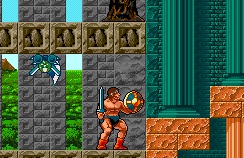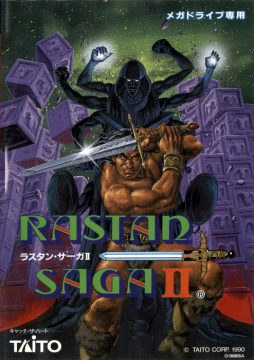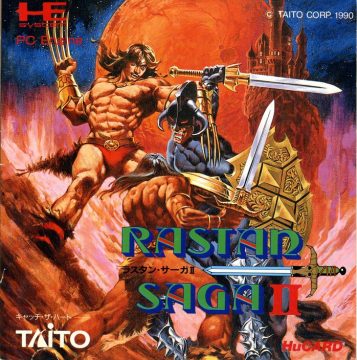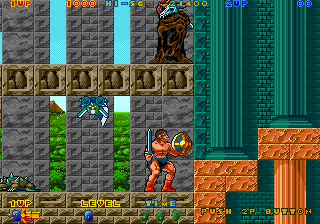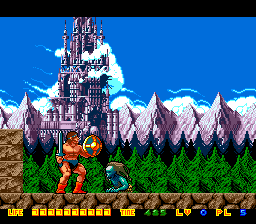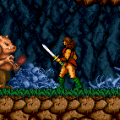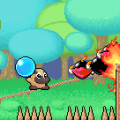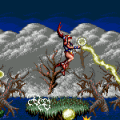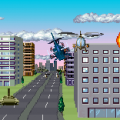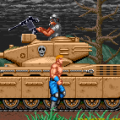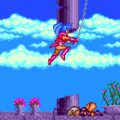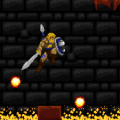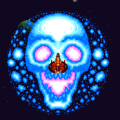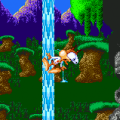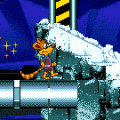Rastan found immediate popularity. To quickly capitalize on this, Taito developed and manufactured a sequel for the arcades in less than a year. Rastan Saga II (known as Nastar or Nastar Warrior in arcades outside of Japan) features higher quality music, more weapons, and the ability to block both high and low attacks. The characters are also much larger, and the graphics are more colorful.
Several extra power-ups are added, as well. Rather than the persistent items found in the original, Rastan Saga II offers items that give your weapons an added lightning attack, one that makes projectiles rotate around you and damage enemies, and an item that kills every foe on the screen. There are also items that increase the game’s timer and refill your life. Of these additions, the most interesting is the ability to block attacks by simply not moving (or crouching to block low attacks). This is a throwback to an early 80s game from Taito called Gladiator, where game progress is based on lining one’s shield up against various incoming obstacles and enemy attacks. The game even offers cooperative play, which is typically a huge plus for any action game. However, even this feature cannot redeem Rastan Saga II.
While more colorful than its predecessor and possessing more available weapons, Rastan Saga II suffers from hit detection that blatantly favors the computer. Graphically, the sprites are significantly larger than those found in most games of this kind, but are very poorly animated, with many enemies having only one or two frames of animation total. To make matters worse, the level design is so banal and linear it makes the original Rastan feel like Elder Scrolls. Rastan’s levels feature a variety of vertical and horizontal movement, various deathtraps to avoid, and a high quality arrangement of platforms to negotiate. Rastan Saga II has no vertical scrolling of any kind, only long, flat stretches of land, with the occasional bout of pits to jump over and a few hills to surmount.
Everything moves more slowly than in the original game, as well. Unlike the semi-intelligent humanoid foes confronted in each palace in Rastan, the sequel’s enemies are all completely brain dead, and follow exactly one form of movement/attack before leaving the screen. Many actually just stand in place and attack when you get within a certain distance, not even turning around if you get behind them.
The biggest flaw, however, is in the boss fights. Unlike the quickly paced and intense duels of the original, each boss is confronted in a wide room with no platforms. This, combined with most of them being far too large to jump over, makes things very difficult. Their patterns are also extremely tedious. This is exacerbated by the fact that while successfully blocking an attack prevents it from damaging you, it has absolutely no affect on the movement of your assailants.
While the game isn’t a total disaster, it is a huge step down from the original. Improvements like the sprite sizes are welcome, but can’t overshadow the rushed and unfinished feel of the overall game. As a final kick, the game’s premise is just plain silly. We know that there is a location called Rastania, which “used to be a sacred place.” We also know that whoever surmounts the tower “Skyscraper” can rule the world. Our hero seeks to stop the Wicked Group (yes, that actually is their name) from doing this.
The ending then speaks of how he will protect this land from any foe. We’re given no indication of who we’re confronting or why at any point in the game, and in a game with such odd boss designs, this is disappointing. The original Rastan isn’t exactly Shakespeare, but it sets up a reason for the carnage that’s at least coherent. Finally, we’re informed that the war of the Rastania is over, and that the one who survived the war is known as a Rastan. Huh?
Rastan Saga II did not gain the same level of popularity as the original, and was only ported from the arcades to the Sega Genesis and PC Engine. The PC Engine release stayed in Japan, while the Genesis port made it to North America. Oddly, Taito suddenly realized that capitalizing on a name involves using that name, and so the Genesis game is titled Rastan Saga II.
Both ports surprisingly have very accurate graphics relative to the power of their respective systems, though they suffer from massive downgrades in sound quality, and the level of detail in the backgrounds is also reduced in exchange for maintaining the large sprite size. In addition, each level of Rastan Saga II has two distinct “halves” to it, broken up by a stone outcropping about half the height of the screen that you need to jump over. In both home ports, this point causes the screen to fade out and fade in after loading the second half of the level. Both ports are single-player only, too.
Rastan Saga II was developed for the Genesis by Opera House. Their particular resume is small, and consists mostly of ports and remakes, most notably Kyuuyaku Megami Tensei for the Super Famicom and Devilish for the Game Gear, along with several ports of Data East arcade games for the Sega Genesis. For the most part, this version of Rastan Saga II is solid. It has terrible sound (also all voiceovers are gone), but maintains the multi-plane scrolling of the arcade game’s backgrounds, as well as its speed.
The PC Engine port was developed by Taito itself. It has noticeably washed out graphics compared to the Genesis version. It’s also plagued with slowdown whenever more than a few sprites are on screen at the same time. That said, the level layout, enemy speed, aggression, and placement is exactly the same as the arcade original. Interestingly, the game actually has to stop to “load” a new weapon whenever you get one rather than bestowing it upon you instantly, as in the arcade and Genesis releases. While the voices and several sound effects are also missing from this version, the music is better arranged on the PC Engine, and sounds closer to the original compositions than the Genesis release.
Three final alterations are actually an improvement to the game. First: in the arcade game, holding Down and the attack button while in the middle of a jump causes you to rapidly attack downwards repeatedly. This gives you zero margin for error when hitting foes below you, as you’re vulnerable save for the split second that your weapon is out. In the home versions, holding Down and attack causes you to keep your weapon held out, making this technique much safer. Second: the combat has been slightly rebalanced. Your invincibility time is longer than the paltry split second you get in the arcade game. In addition, some of the heavier enemy types take fewer hits to destroy in these home ports than they do in the arcade version. This doesn’t alter the game’s difficulty (since these are foes that in most cases don’t even move), but instead improves its pacing. Third: the half-second delay and accompanying sound effect that occurs whenever you jump is gone in the home ports, making for much faster jumping and smoother movement control overall. The PCE version is also on the Wii Virtual Console.
